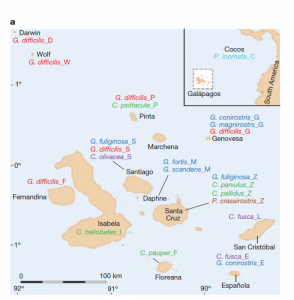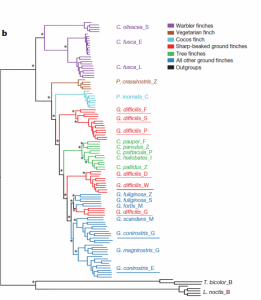Introduction
Darwin’s finches from Galapagos and Cocos Island are classic example of young adaptive radiation, entirely intact because none of the species having become extinct as a result of human activity. They have diversified in beak sizes and shapes, feeding habits and diets in adapting to different food resources. Although traditional taxonomy of Darwin’s is based on morphology and has been largely supported by observations of breeding birds finches, in this paper, authors showed the results of whole-genome re-sequencing of 120 individuals representing all of the Darwin’s finch species inhabiting Galapagos archipelago (Fig. 1a) and two close relatives, trying to analyse patterns of intra-and interspecific genome diversity and phylogenetic relationships among the species.
Figure 1a. Sample location of Darwin’s finches
Summary and comments of the paper
The authors analyzed location and phylogeny of Darwin’s finches and found widespread evidence of interspecific gene flow that may have enhanced evolutionary diversification throughout phylogeny. They also reported discovery of a locus with the major effect on beak shape. They generated 10x sequence coverage per individual bird and using 2×100 base-pair (bp) paired-end reads and found evidence of introgression from three sources: ABBA-BABA tests, discrepancies between phylogenetic trees based on autosomal and sex linked loc, and mtDNA. Extensive sharing of genetic variation among populations was evident, particularly among ground and tree finches, with almost no fixed differences between species in each group. Their maximum-likelihood phylogenetic tree based on autosomal genome sequences is generally consistent with current taxonomy showing several interesting deviations (Fig. 1b).
Figure 1b. Phylogeny of Darwin’s finches
Revised and dated phylogeny of Darwin’s finches shows that the adaptive radiation took place in the past million years, with a rapid accumulation of species recently. Genomic characterization of the entire radiation revealed a striking connection between past and present evolution. Evidence of introgressive hybridization is found throughout the radiation, showing that hybridization always gives rise to species of mixed ancestry, which is explained in detail (species and location) in this paper. The most obvious morphological difference among Darwin’s finches concerns beak shape. The authors performed a genome wide scan on the basis of populations that are closely related but show different beak morphology. In this study, they indicated a polygenic basis for beak diversity, discovering 15 regions with strong genetic differentiation between groups of finches with blunt or pointed beaks. Their analysis revealed that ALX homeobox 1 is an excellent candidate for variation in beak morphology, because it encodes a paired-type homeodomain protein (transcription factor), that plays a crucial role in development of structures derived from craniofacial mesenchyme, the first branchial arch and the limb bud, and have influence on migration of cranial neural crest cells, highly relevant to beak development. They observed single nucleotide polymorphisms (SNPs) in ALX1 gene of various finch species and concluded that blunt haplotype has a long evolutionary history because it’s origin predates the radiation of vegetarian, tree and ground finches. The haplotype might have evolved by accumulating both coding and regulatory changes affecting ALX1 function. Natural selection and introgression affecting this locus have contributed to the diversification of beak shapes among Darwin’s finches and hence to their expanded utilization of food resources on different Galapagos islands.
Lamichhaney, S., Berglund, J., Almén, M., Maqbool, K., Grabherr, M., Martinez-Barrio, A., Promerová, M., Rubin, C., Wang, C., Zamani, N., Grant, B., Grant, P., Webster, M., & Andersson, L. (2015). Evolution of Darwin’s finches and their beaks revealed by genome sequencing Nature, 518 (7539), 371-375 DOI: 10.1038/nature14181


